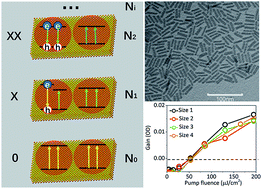当前位置:
X-MOL 学术
›
Chem. Sci.
›
论文详情
Our official English website, www.x-mol.net, welcomes your
feedback! (Note: you will need to create a separate account there.)
A model for optical gain in colloidal nanoplatelets†
Chemical Science ( IF 7.6 ) Pub Date : 2017-11-13 00:00:00 , DOI: 10.1039/c7sc04294a Qiuyang Li 1, 2, 3, 4 , Tianquan Lian 1, 2, 3, 4
Chemical Science ( IF 7.6 ) Pub Date : 2017-11-13 00:00:00 , DOI: 10.1039/c7sc04294a Qiuyang Li 1, 2, 3, 4 , Tianquan Lian 1, 2, 3, 4
Affiliation

|
Cadmium chalcogenide nanoplatelets (NPLs) and their heterostructures have been reported to have low gain thresholds and large gain coefficients, showing great potential for lasing applications. However, the further improvement of the optical gain properties of NPLs is hindered by a lack of models that can account for their optical gain characteristics and predict their dependence on the properties (such as lateral size, concentration, and/or optical density). Herein, we report a systematic study of optical gain (OG) in 4-monolayer thick CdSe NPLs by both transient absorption spectroscopy study of colloidal solutions and amplified spontaneous emission (ASE) measurement of thin films. We showed that comparing samples with the same optical density at the excitation, the OG threshold is not dependent of the NPL lateral area, while the saturation gain amplitude is dependent on the NPL lateral area when comparing samples with the same optical density at the excitation wavelength. Both the OG and ASE thresholds increase with the optical density at the excitation wavelength for samples of the same NPL thickness and lateral area. We proposed an OG model for NPLs that can successfully account for the observed lateral area and optical density dependences. The model reveals that OG originates from stimulated emission from the bi-exciton states and the OG threshold is reached when the average number of excitons per NPL is about half the occupation of the band-edge exciton states. The model can also rationalize the much lower OG thresholds in the NPLs compared to QDs. This work provides a microscopic understanding of the dependence of the OG properties on the morphology of the colloidal nanocrystals and important guidance for the rational optimization of the lasing performance of NPLs and other 1- and 2-dimensional nanocrystals.
中文翻译:

胶体纳米血小板的光学增益模型†
据报道,硫化硫镉纳米片(NPL)及其异质结构具有低增益阈值和大增益系数,显示出在激光应用方面的巨大潜力。但是,由于缺乏能够解释其光学增益特性并预测其对特性的依赖性(例如横向尺寸,浓度和/或光学密度)的模型,阻碍了NPL光学增益特性的进一步改善。本文中,我们通过胶体溶液的瞬态吸收光谱研究和薄膜的放大自发发射(ASE)测量,对4单层厚CdSe NPL中的光学增益(OG)进行了系统的研究。我们显示,比较激发时具有相同光密度的样品,OG阈值不依赖于NPL侧向面积,当比较在激发波长下具有相同光密度的样品时,饱和增益幅度取决于NPL侧向面积。对于NPL厚度和侧面面积相同的样品,OG和ASE阈值都随激发波长处的光密度而增加。我们为不良贷款提出了一种OG模型,该模型可以成功解决观察到的横向面积和光密度依赖性。该模型表明,OG源自双激子态的受激发射,当每个NPL的平均激子数约为带状激子态占一半时,OG阈值就达到了。与QD相比,该模型还可以合理化不良贷款中较低的OG阈值。
更新日期:2017-11-13
中文翻译:

胶体纳米血小板的光学增益模型†
据报道,硫化硫镉纳米片(NPL)及其异质结构具有低增益阈值和大增益系数,显示出在激光应用方面的巨大潜力。但是,由于缺乏能够解释其光学增益特性并预测其对特性的依赖性(例如横向尺寸,浓度和/或光学密度)的模型,阻碍了NPL光学增益特性的进一步改善。本文中,我们通过胶体溶液的瞬态吸收光谱研究和薄膜的放大自发发射(ASE)测量,对4单层厚CdSe NPL中的光学增益(OG)进行了系统的研究。我们显示,比较激发时具有相同光密度的样品,OG阈值不依赖于NPL侧向面积,当比较在激发波长下具有相同光密度的样品时,饱和增益幅度取决于NPL侧向面积。对于NPL厚度和侧面面积相同的样品,OG和ASE阈值都随激发波长处的光密度而增加。我们为不良贷款提出了一种OG模型,该模型可以成功解决观察到的横向面积和光密度依赖性。该模型表明,OG源自双激子态的受激发射,当每个NPL的平均激子数约为带状激子态占一半时,OG阈值就达到了。与QD相比,该模型还可以合理化不良贷款中较低的OG阈值。











































 京公网安备 11010802027423号
京公网安备 11010802027423号